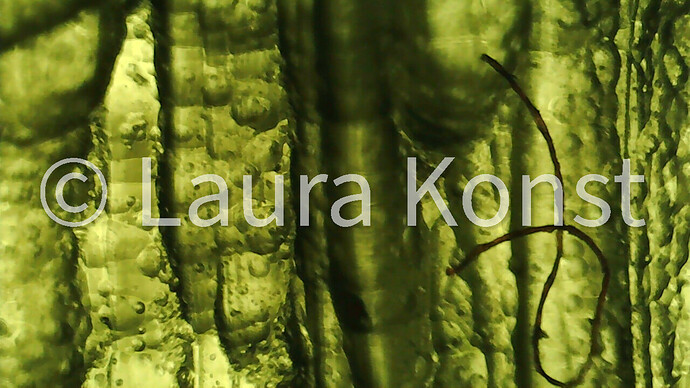Hi!
I am checking out my Moldavites under the microscope and what is this inclusion!? Could it be lechatelierite quite deep so it actually looks like a piece of grass?
Before anyone comments on the colour, I used a green colour underneath as well.
Thanks!
Those are gas bubbles - inclusions that were formed when the asteroid melted as it entered the atmosphere and then cooled down after hitting earth.
I mean that inclusion that looks like grass/hair/alien eyelash 
OH, I see that now. For some reason, I thought it was writing.
Something definitely got mixed in there prior to it hardening, but what is anybody’s guess. This is WAY out of my league. You’ll need to seek out a sleuth with a high powered microscope and knowledge of the flora and fauna of that time and area to get your answer.
My guess is some type of hair, maybe from a yeti 
Good luck.
Thats very Interesting as actual Moldavites pretty much annihilated everything when what ever it was crammed into the earth. It took out a large Miles of forest. I appraise moldavites all the time in my lab and I can’t say I have ever seen anything but sand do to the intense heat it pretty much melted everything to glass. So that being said are you positive this is not a man made Moldavite/Fake. There are a lot of those out there ( EBAY) where contaminates like an eye lash or pet hair could have gotten in the mix. The best thing to do is first find out exactly where this came from or is claimed to come from. Second have it tested in a Lab ( mine or someones else) to verify it’s authentic. If you haven’t already. Look for inclusions from lechatelierite & bubbles (which I see there are bubbles however those can be is good fakes as well although less common. - Mike Grimaldi Acquire Collectibles Gemological Lab/ IGS Certified Professional Gemologist
1 Like
P.s. the thing that is trapped in your sample looks actually like an insect leg with a minor Tibial Spur. Look at it under High magnification. - Mike Acquire Collectibles Gemological Lab.
2 Likes
Hi Mike!
Thanks for your great answer. It actually does look like a bug leg.
I’ve got my Moldavite from a UK gemstone supplier, who’s in the business for decades. Who bought it at the Tucson gemstone show from the guys from Czech Republic.
I’ve found lechatelierite, luckily and the bubbles are in random order.
From what I understood, most fake ones their bubbles and lines are very symmetrical basically on all pieces due to the molds? Or is it more sophisticated now already?
Thank you!
The con artist have gotten much better at making fakes these days and it takes a trained eye with a good microscope and even then that’s not a test but rather an observation hoping to find something, anything, that proves it’s visually a fake or not. There are tests that are hard to fool but like everything else the Con artist are trying their best to trick the Labs. See it everyday from many countries. Especially with EBAY. I’ve purchased gemstones that the Seller swears are genuine earth mined and once tested are lab created or even simple glass. It’s a real shame but keeps me busy with all the testing etc. Many times unfortunately folks want to hear what they want to hear or believe. My suggestion is treat every gemstone or fossil or tektite purchase with some caution, understand that price is not always indicative of quality or authenticity and even the best get fooled from time to time. Learn as much as you can about what ever your purchasing. Really take the time to look at oddities in Moldavities and the such and apply good old common sense and logic first, then the microscope and then the proper testing! - Mike
1 Like
It appears to be a mono-filament clothing fiber which is on the surface of the stone and not inside the stone. A thorough cleaning may resolve the issue. I see fibers like this quite often when the item is stored in one of those black velvet lined presentation boxes. ;))


